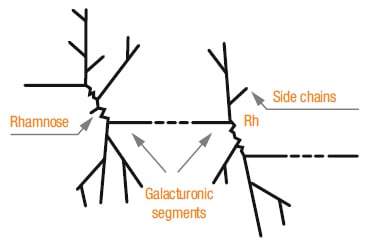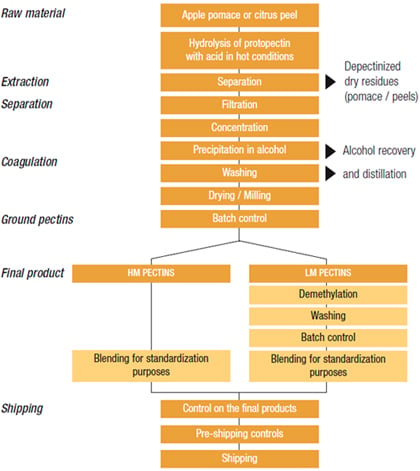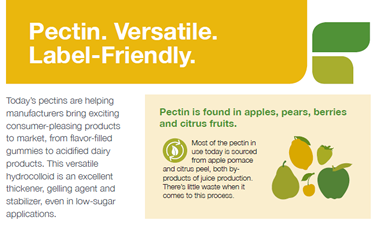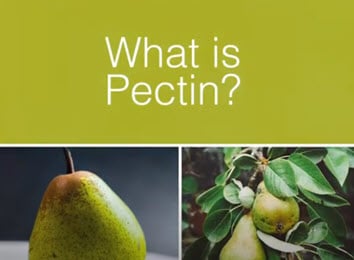Pectin
Pectin: A Versatile IngredientPectin is an ingredient and a natural component of plants that is especially abundant in apples and citrus fruits. Fruit pectin is associated with cellulose in plant tissues, where it plays a fundamental role in determining their mechanical properties. Pectin, as a food ingredient, can be used as a gelling agent, thickening agent and stabilizer in food applications. Cargill is a pectin supplier to the food industry. Pectin is used in diverse applications such as yogurt, confectionery and acid milk drinks. Pectin has the image of a natural product and has acknowledged nutritional benefits. Pectin is also used to optimize the mouthfeel of fruit-based beverages and as a protein stabilizer in acidified dairy products. |
Learn more about pectin
Applications
Confectionery
-
HM Pectin
- Fruit paste (combined with gelatin)
- Gelled articles (combined with gelatin)
-
LM Pectin
- Miscellaneous
Dairy
-
HM Pectin
- Stabilization of acid dairy drinks
-
LM Pectin
- Yogurts
- Fruit preparations for yogurts
- Fruit preparations for dessert creams
- Fruit applications
Fruits & Vegetables
-
HM Pectin
- Traditional jams
- Fruited beverages
-
LM Pectin
- Low calorie jams
- Fruit preparations for yogurts
- Preparations for baking/pastry fillings
Brand
- Unipectine® Pectin
Functionality
Pectin for use in food is defined as a polymer containing at least 65% galacturonic acid units. The acid groups may either be free or be methylesterified, sodium, potassium, calcium or ammonium salts. In some commercial pectins amide groups also may be present.
The regular structure is interrupted by the presence of L-rhamnose, which causes deviations called "pectic elbows". The L-rhamnose is linked by carbons 1 and 2.
Galacturonic Acid

The proportion of the galacturonic acids that are in the methyl ester form, is called the “degree of esterification” (DE) or “degree of methoxylation” and is quoted as a percentage. DE affects the behavior of pectin.
High methoxyl (HM) pectins are defined as those with a DE equal to or above 50, while low methoxyl (LM) pectins have a DE of less than 50. LM pectins can be acid or alkali-treated. LM pectins also can be either amidated (LMA) or non-amidated (LMC).
The % level of substitution of the amide group is defined as the “degree of amidation” (DA) and also is very important to the performance of a pectin.
DE and DA provide a good classification of pectins, and while these values can help identify the expected behavior of a pectin, additional properties are more suited to define its functionality, e.g. SAG, setting temperature and viscosity.
In the fruit, pectin has a very high degree of esterification (DE). During the acid hydrolysis used to extract it, some of the esters are converted into the free acid form, or saponified. By careful control of this process, HM pectins with different degrees of esterification are obtained. The higher the DE, the faster the setting rate, so depending on the DE these pectins are classified as Rapid Set (RS), or Slow Set (SS) for example.
In general, LM pectins can be obtained either by acid or alkaline hydrolysis. However, amidated LM pectins can only be produced by hydrolyzing under alkaline conditions using an ammonia solution. Under these conditions, some of the esters are converted to amide groups, a process which alters the pectin's rheology and calcium reactivity.
Correct preparation of the pectin solution is a key initial preparatory step. Incomplete dissolution is a frequent cause of unsatisfactory performance. A pectin which is easy to handle must have the following characteristics: good dispersibility, high dissolution rate and maximum solubility.
Pectin solutions are stable under acid conditions (between pH 3.2 and 4.5), even at high temperatures. They also are stable for several hours at room temperature under more alkaline conditions, but degrade rapidly at high temperature.
HM pectins form thermostable gels when the pH is low (less than 3.5) and the sugar concentration is high (dry matter content greater than 60%). When the dry matter is less than 60%, LM pectins have to be used. The pH and the dry matter content, more than the gel strength affect the rate of gelation. LMA pectins are generally thermoreversible. However, non-amidated LM pectins can form thermostable gels.
Gel formation is not the only function of pectins, HM pectins are excellent stabilizers of acid milk drinks. They coat the casein particles, stopping them from aggregating to prevent sedimentation problems. LM pectins can provide a wide range of textures and rheological properties, depending on the calcium concentration and the calcium reactivity of the pectin chosen.
HM pectins also are very attractive viscosifiers for soft drinks. Here the pectin builds a similar mouthfeel to that of fruit juices, and is therefore useful in juice drinks and in low calorie or diet drinks. In addition, HM pectins have the advantage of delivering a very clean flavor release. In this case, the viscosity is created simply by the behavior of the pectin in the solution.
From a nutritional point of view, pectin is an interesting dietary fiber. Early research indicates that it has physicochemical properties which may positively influence several biomarkers that influence cardio-vascular and digestive functions. It may act as a cholesterol-lowering agent and preliminary research shows that it can impact gut health. Our scientific team will be glad to provide the necessary information.
Manufacturing Process
In plant cells, pectin is linked to cellulose to form protopectin which has the ability to absorb large amounts of water. Cellulose gives the supporting tissues their rigidity while the pectic components give the plant its flexibility. The production of pectin consists of five main steps:
- Hydrolysis
- Separation of liquids from solids
- Purification
- Recovery
- Standardization

Regulatory
Pectin is generally regarded as a safe food substance. Its composition and use is regulated under food additive law in the EU, and it is GRAS in the USA. It is also included in the International Codex Alimentarius. Particular references include:
FAO/WHO - Codex Alimentarius
Pectins have been given an Acceptable Daily Intake (ADI) of "not specified" by the FAO/WHO Joint Expert Committee on Food Additives (JECFA), and are listed on that basis in the Codex General Standard for Food Additives.
European Union
Pectin (E440 (i)) and Amidated Pectin (E440 (ii)) have both been given an ADI "not specified" by the Scientific Committee for Food. Specifications are listed in Commission Directive 98/86/EC of 11th November 1998, published in Volume 41, Issue L334 of the Official Journal. Pectins may be used under "quantum satis" conditions in most foods.
United States
The FDA recognizes pectin as GRAS (generally recognized as safe). It may be used in all non-standardized foods and in accordance with the Code of Federal Regulations (21CFR 184.1588).
Japan
The Ministry of Health, Labour and Welfare recognizes pectin under The Japan's Specifications and Standards for Food Additives.
In other countries, food legislative authorities generally recognize pectin as an important and safe food substance . Where regulated, permitted use levels are generally in accordance with “Good Manufacturing Practice.”
Cargill’s global team of regulatory and food law experts will be glad to provide assistance on regulatory, nutrition-related claims and food law-related issues.

Gelatin has traditionally been the go-to gelling agent for chewy treats, but plant-based trends have confectioners re-thinking their formulas. Fruit-based pectin is an excellent solution.
Download
From plant-based dairy alternatives to low-calorie beverages, learn how pectin is helping brands respond to today’s biggest marketplace trends.
Download
An excellent thickener, gelling agent and stabilizer, today’s pectin is a source for satisfying mouthfeel in reduced-sugar beverages, shelf-stable appeal in low-pH dairy beverages, and flavorful gummies with label-friendly appeal.
Download
A-peeling pectin finds growing market for reduced-sugar, label-friendly formulation. This time-tested ingredient is sparking new innovations, as formulators rediscover its aptitude for thickening, gelling and protein stabilization.
Download
Snapshot of how pectins help manufacturers bring pleasing products to market.
Download
When shoppers see pectin on an ingredient label, they may be flooded with memories of their Grandmother’s sweet strawberry jam. But this versatile ingredient has changed drastically over the past decade.
Download
Technical advancements in pectin – as well as consumer’s interest in label-friendly and reduced-sugar products – have encouraged more manufacturers to include this fruit-derived thickener and gelling agent in product formulations.
Download
Some Cargill products are only approved for use in certain geographies, end uses, and/or at certain usage levels. It is the customer's responsibility to determine, for a particular geography, that (i) the Cargill product, its use and usage levels, (ii) the customer's product and its use, and (iii) any claims made about the customer's product, all comply with applicable laws and regulations.


